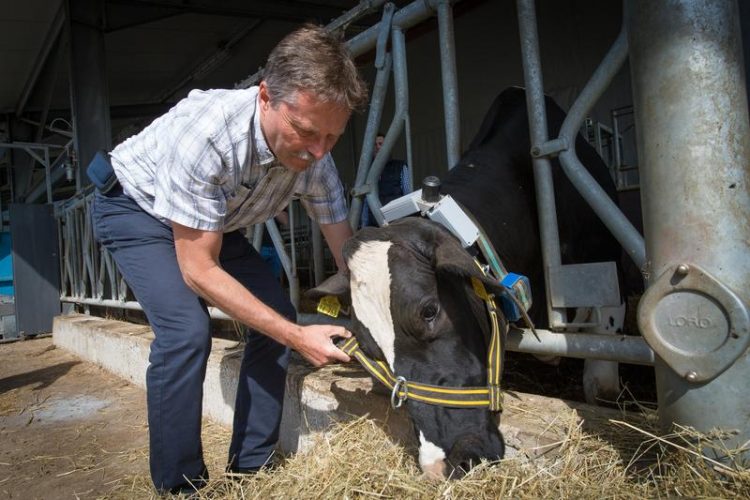The Expo Presents: Wellness for Dairy Cows

Prof. Dr. Wolfgang Buescher with a cow in the high-tech barn at Gut Frankenforst, a teaching and research station that is part of the University of Bonn. © Photo: Volker Lannert/Uni Bonn
Gilette trots over to the trough, takes her time munching some feed, and makes a little detour to the brush, which starts spinning automatically thanks to a motion sensor. Gilette clearly enjoys the feeling of the brush on her hide. Then it is time to slurp up some water from the trough. Basically, Gilette is acting like any other dairy cow.
But without realizing it, the animal is generating a huge volume of data every day. Countless sensors record how much of the feed she has eaten, how much water she drinks, whether her heart is beating quickly or slowly. In addition, no movement escapes the pedometers and the video cameras mounted in the barn.
Scientists research the dairy industry of the future
A total of about 60 dairy cows live in the high-tech barn at Gut Frankenforst, a teaching and research station that is part of the University of Bonn. The researchers from the Center of Integrated Dairy Research (CIDRe) are gathering all this data to explore the animal husbandry of the future:
How should a barn be designed to make sure the cows are comfortable and produce the best milk? How much feed, and what type, do the animals need during the recovery phase after calving? How can the sensor data help them determine early on whether a cow is getting sick?
The agriculture researchers’ computers at the University of Bonn are now collecting all of this sensor data, and the findings are analyzed separately for each animal. “It’s hard to tell how a cow feels just from looking at the measurement data,” explains CIDRe spokesman Prof. Dr. Wolfgang Büscher, “because every animal is different.” For instance, some cows have faster heartbeats than others. As a result, the researchers need to spend a long time collecting data in order to recognize individual patterns. “Then we can recognize deviations from the norm,” reports Dr. Susanne Plattes.
The video cameras provide additional information. What is the cow doing right now? Standing up or lying down, running or playing with a companion? “Looking at the images lets us interpret the sensor data more accurately, for instance for the heartbeat,” says the veterinarian. Even the milking station automatically records data about the cows’ milk flow. “If a cow is producing less milk, we can tell, among other things, whether she is developing an udder infection,” says Plattes. In that case, the animal can be treated sooner, before it turns into a serious illness.
CIDRe: a coalition of various institutes
Early 2012 saw the launch of CIDRe, which combines many different projects under one roof. The unique equipment in the high-tech barn at the Frankenforst research site plays a central role, but CIDRe is also a virtual coalition of 20 professors and academic employees from a wide range of disciplines at the University of Bonn, cooperating with Free University Berlin and other institutions. Economists, for instance, investigate the ideal conditions for producing milk cost-effectively in the future.
At the Riswick site belonging to the NRW Chamber of Agriculture, near Kleve, researchers are exploring how to minimize greenhouse gas emissions from the ruminants’ stomachs by optimizing their feed mixtures. What elements does milk provide for human nutrition? Thanks to the participation of microbiologists and nutritional scientists, research on milk as a food product has been expanded recently.
CIDRe at EXPO 2015 in Milan
The Center of Integrated Dairy Research at the University of Bonn is a research partner for the ARGE German Pavilion at the EXPO 2015 World’s Fair in Milan, which opened on May 1. Visitors will be able to go to the German Pavilion until October 31, 2015, to learn about various scientific projects like the one being carried out in the high-tech barn in Frankenforst.
The participants
On behalf of the German Ministry of Economics and Energy, Messe Frankfurt has charged the German Pavilion Working Group for EXPO 2015 in Milan (ARGE) with realizing the German Pavilion. As the general contractor, ARGE is responsible for planning and building the German Pavilion, and for the exhibition. Schmidhuber, from Munich, is responsible for the spatial concept, architecture and general planning; Milla & Partner, from Stuttgart, is responsible for the content and for designing the exhibition and media. Nüssli, from Roth near Nuremberg, is handling the project management and construction work.
Media contact:
Dr. Susanne Plattes
CIDRe (Center of Integrated Dairy Research)
University Bonn
Tel: 0228/739418 or 06552/6009915
Email: cidre@uni-bonn.de
http://bit.ly/milchkuh Podcast on this topic
http://www.CIDRe.uni-bonn.de About the Uni Bonn project
http://www.expo2015-germany.de About the German Pavilion
http://en.expo2015.org About the Expo
Media Contact
All latest news from the category: Trade Fair News
Newest articles

Properties of new materials for microchips
… can now be measured well. Reseachers of Delft University of Technology demonstrated measuring performance properties of ultrathin silicon membranes. Making ever smaller and more powerful chips requires new ultrathin…

Floating solar’s potential
… to support sustainable development by addressing climate, water, and energy goals holistically. A new study published this week in Nature Energy raises the potential for floating solar photovoltaics (FPV)…

Skyrmions move at record speeds
… a step towards the computing of the future. An international research team led by scientists from the CNRS1 has discovered that the magnetic nanobubbles2 known as skyrmions can be…





















